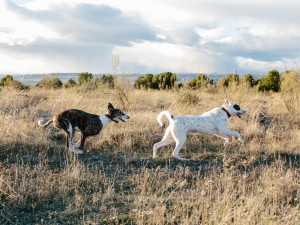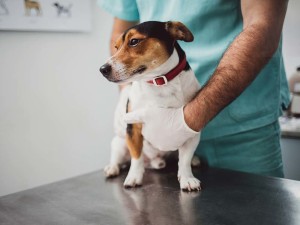Treatment for Your Dog’s Bleeding Anus: Home Remedies and Medical Options
It’s not a pretty problem, but here are your solutions.
In This Article:
What Are the Symptoms of a Bleeding Anus in Dogs? What Could Be Causing My Dog’s Bleeding Anus? Should I Take My Dog to the Vet if They Are Bleeding from Their Anus? How to Treat Dog Anal Bleeding What Are Home Remedies for a Dog’s Bleeding Anus? Can You Prevent a Bleeding Anus in Dogs? Frequently Asked Questions
It can certainly be alarming to discover that your dog is bleeding, especially if they seem to be bleeding from their butt. There are many potential causes for bleeding in or around the anus, including anal gland disease, dietary issues, intestinal parasites, and/or infections. There are home remedies for this bleeding, but pet parents should consult a veterinarian before attempting any treatment and seek their help immediately for severe or persistent symptoms.
There’s going to be a lot of butt and butt-adjacent discussion in this article, so put down your lunch and brace yourself for a deep dive.
Snap a pic of your pup’s teeth, and GREENIES™ will help you spot potential signs of oral health issues.
Key takeaways
There are many potential causes for bleeding in or around the anus.
It is important to seek veterinary treatment any time your dog is actively bleeding.
There are steps you can take at home to make your pup more comfortable and to prevent future episodes of bleeding.
What are the symptoms of a bleeding anus in dogs?
The most obvious symptom of a bleeding anus in a dog is going to be rectal bleeding or bleeding around their butt. Sometimes, though, you can’t tell where the bleeding is coming from, especially if your dog is in pain and is also hiding or lying down. Additional symptoms will depend on the underlying cause of the bleeding, and this may be related to structures around the anus, including the anal glands and/or tail, as well as internal structures like the intestines, colon, and/or rectum. Some of these symptoms include:
How much do you spend on your pet per year?
Drops of blood on the ground and/or around your dog’s hind end
Discomfort or straining when pooping
Blood in their poop (this may include diarrhea)
Excessively licking their rear end
Blood around the mouth (transferred from licking)
Hiding
Whining or acting painful
Swelling around the anus
Reluctance to walk and/or walking with their tail tucked
What could be causing my dog’s bleeding anus?
Blood coming from or found around a dog’s anus can have many sources. Knowing a little local anatomy can help to narrow down the causes of a bleeding anus in the dog:
The rectum is the final few inches of the large intestine. The rectum is important because it stores stool prior to defecation, reabsorbs water from that stored poop, and triggers defecation when full.
The anus is the very end of the intestinal tract. It’s normally held shut by muscular rings that keep poop from falling out. During defecation, these muscles will relax to allow the passage of stool.
A dog’s anus has two small anal sacs tucked between those muscular rings. These glands sit at the four o’clock and eight o'clock positions around the anus and are connected to small openings on the anus by a short duct. These normally empty a little bit of scent-marking fluid during defecation or when a dog is startled.
The perianal region is the area of skin around the anus, while the perineum is the area between the anus and genitals. There’s some overlap, and some people use the terms interchangeably even though they’re technically different.
Determining the source of the bleeding is the first step in figuring out why your dog has a bloody butt. You can start by trying to lift their tail (easier said than done in some breeds) and taking a look around for any obvious wounds, swellings, or asymmetry. If your dog is in a lot of pain, they may resist your attempts to lift their tail, or may even growl or hide; this is a good indication that they are really uncomfortable and need to get to the vet right away for pain relief and more targeted treatments.
If you are able to peek under their tail and nothing seems amiss, the blood may be coming from the rectum or even higher up in the digestive tract where you can’t see it. Causes of bleeding in or around the anus include:
Colitis
Inflammation of the colon and/or rectum can cause diarrhea with mucus and fresh red blood. Many dogs with colitis are also straining to poop and need to poop frequently and with urgency, which may lead to accidents inside. Colitis can have many causes, including infections, intestinal parasites, sudden changes in diet, or dietary indiscretion (eating garbage, people food, fatty or greasy snacks, etc.).
Hemorrhagic gastroenteritis (HGE)/acute hemorrhagic diarrhea syndrome (AHDS)
This scary disease can make dogs very sick very quickly. These dogs have a large amount of very bloody diarrhea, often described as having a raspberry jam appearance. It comes on quickly and may be accompanied by vomiting, anorexia, lethargy and/or belly pain. This syndrome requires prompt veterinary care to prevent life-threatening complications like dehydration.
Polyps or masses
Polyps or cancerous tumors can originate from the wall of the colon or rectum, and bleeding can occur when these growths are irritated by passing stool. This can result in bleeding that is often seen as bloody streaks on the surface of their poop.
Intestinal parasites
Hookworms, roundworms, giardia, and whipworms are some of the most common parasites found in dogs. Any parasitic infection could potentially cause enough irritation to result in bleeding, usually in the form of bloody diarrhea. Hookworms and whipworms tend to be the worst because they do more damage when they latch onto the intestinal walls to feed.
Bleeding disorders
Some dogs are born with bleeding disorders like hemophilia or von Willebrand’s disease that leave them unable to clot their blood properly. More commonly, dogs develop bleeding problems from ingesting certain toxins, such as rat poison, or as a result of immune-mediated disease. No matter the cause, when a dog has a bleeding disorder, everyday activities and mild traumas can lead to excessive bleeding anywhere in or on the body. This includes in their poop or around their rectum. Many times, these dogs will have other signs as well, including pale gums, bruises, or red splotches on their skin.
Trauma (foreign material)
Dogs love to eat stuff they shouldn’t. Puppies especially enjoy putting whatever they find in their mouths to figure out if it’s tasty and fun to chew. Sometimes, dogs swallow these non-digestible things without their parents noticing. If it doesn’t get stuck in their intestines along the way, these objects will eventually be excreted in their poop. These objects can scrape things up as they make their way through the intestines and out of the anus. Small bits of chewed plastic with jagged edges and sharp pieces of bones are especially traumatic, causing bleeding and pain.
Anal gland abscess
Those pesky scent glands around the anus can develop clogged ducts that lead to a blockage. Blockage of these ducts can lead to infection and abscess formation. This appears as a very angry-looking swelling on one side of the perianal area. It is extremely painful, and left untreated, this swelling will eventually rupture and leak a foul-smelling fluid containing blood and pus.
Perianal fistulas
Some dogs can have chronic irritation of the perianal skin and eventually develop draining tractsopens in new tab. These non-healing wounds cause continual irritation and can leak blood or pus. This disease is not common and is most frequently seen in German Shepherds.
Food allergies and/or dietary issues
Food allergies in dogs can present with many different signs. These dogs tend to be generally itchy and have skin issues, including chronic ear infections and anal gland problems. They may scoot their butts on the ground in an attempt to relieve their itchiness, leading to inflamed and irritated skin, which may be prone to bleeding. They may also develop anal gland abscesses that can bleed as well. Some dogs with food allergies will also have digestive problems, including chronic diarrhea, which can lead to blood in their stool or bleeding from their rectum due to irritation from ongoing diarrhea.
Should I take my dog to the vet if they are bleeding from their anus?
Yes, it is a good general rule to have your pup examined if they are actively bleeding, especially if you are unsure of where it’s coming from and why. Additionally, it is important to seek immediate care if your pup has additional signs of illness, including pain, lethargy, loss of appetite, vomiting, pale gums, or other signs of serious illness. Your vet can help determine the cause of the bleeding and start targeted treatments that will help your dog feel better quickly.
How to treat dog anal bleeding
The treatment for your dog’s bleeding will vary depending on the cause. For external causes like an anal gland abscess or other traumatic injuries, the skin and the wound will need to be cleaned and medicated. For internal causes, including bloody stool, treatment will include a combination of medications to treat the underlying cause and supportive care measures to keep your pup comfortable and hydrated.
It is very important to seek veterinary attention first to determine which of these problems is causing your dog to bleed and to be sure your pup receives life-saving care if they are having a more serious problem like a bleeding disorder or HGE.
What are home remedies for a dog’s bleeding anus?
You should always contact your veterinarian’s office before attempting any at-home care for a bleeding dog. Most of the time, your pup will need veterinary care right away to address signs like pain, nausea, vomiting, dehydration, and/or infection. If you’ve already been to the vet and are looking for ways to support your pup at home, you can try:
Dietary adjustments
A diet change is often recommended for conditions that cause diarrhea. Your veterinarian may prescribe a specially formulated diet that is bland and easily digestible. You can also cook a bland diet consisting of plain boiled boneless, skinless chicken breasts and white rice at home until symptoms have passed. Even though dogs usually love it, this type of diet is not balanced for long-term feeding, so make sure to gradually switch back to their regular, nutritionally complete diet once they are recovered.
Probiotics
Probiotics can be used to help restore beneficial bacterial populations to the gut and can help reduce inflammation in the intestines. There are probiotics that are made especially for dogs because they have a different population of bacteria in their guts compared to humans. Probiotics can be helpful for many causes of a bleeding anus in dogs because they help repopulate the gut with good microbes, which is especially important after an illness or after taking antibiotics.
Warm compress
For wounds or swelling around the anus, such as with an anal gland abscess, a warm compress may be recommended to help speed healing. Sometimes, a switch to a cool compress after the initial treatment can help to reduce inflammation and swelling, too. Follow your veterinarian’s recommendations and respect your dog’s tolerance for compresses on their butt. If they are very sore back there, they really may not want to be touched, so be sure to speak with your vet about other safe ways to manage their pain.
Can you prevent a bleeding anus in dogs?
There’s no specific prevention for a bleeding anus in a dog because there are so many possible causes for this condition. However, there are some proactive steps you can take to prevent certain conditions, including:
Regular vet check-ups
This is always going to be the best preventative measure you can take for your pup. Regular vet visits allow your vet to catch medical conditions early before they snowball into emergencies. It also gives your vet the chance to keep your dog up-to-date on vaccines, deworming, anal gland expression, and other preventative health measures that will prevent them from getting sick.
Feed a balanced, healthy diet
This one sounds obvious in theory, just like we all know we should eat a healthy, balanced diet, too. While putting it into practice is not always as easy as it sounds, this is another very important way to keep your dog healthy and avoid digestive emergencies. If you have a picky dog, be sure to consult your vet and find a balanced diet that works for them, instead of feeling like you have to give them whatever they’ll eat. Keep treats to a minimum and be very careful about sharing table food with your dog, especially if you don’t know all the ingredients. Most of all, do not let your dog eat non-food items. Be sure to use strategies like crate training, “leave it” cues, and/or a basket muzzle to keep your pup safe.
Parasite prevention
You might be surprised to learn how common intestinal parasites are, but they really can find their way into almost any dog. Be sure you are using routine parasite prevention to keep your pup protected. Many flea and tick preventatives also include a dewormer so be sure to find one that meets your needs.
Maintain a healthy weight
For overall good health, it is important that your dog maintain a healthy weight. This means making sure they are neither underweight nor overweight. You should feed your dog based on the serving size recommended for their age, weight, and activity level. If you minimize treats and table snacks and give your pup plenty of opportunities for their exercise, they should maintain a healthy weight. If you are concerned about your dog’s weight or feel like you are doing all the right things and your dog still can’t maintain a healthy weight, be sure to consult your vet to rule out underlying medical conditions.
The bottom line: Bleeding from the anus can be caused by many different medical conditions. It is important to seek veterinary care right away in order to get a proper diagnosis and effective treatment for your pup. There are some strategies you can use to prevent some of these conditions, so be sure to keep up with your dog’s routine preventative care and healthy habits
FAQs
Can a bleeding anus be a sign of a serious disease like cancer?
Yes, some forms of cancer can cause bleeding from the anus, though that is not the most common reason to find blood there. Consult your vet to get a diagnosis as soon as you notice bleeding.
Is it possible for a bleeding anus to resolve on its own?
It may be possible for a bleeding anus to resolve on its own, depending on the cause. However, even if the condition can be resolved without specific treatment, your dog is likely to be very uncomfortable in the meantime. Veterinary care is important not only to treat the underlying cause and make a proper diagnosis but also to provide prompt relief to your pup.
Is there anything I can do to support my dog during their recovery?
The best way to help your dog recover is to give them lots of love and support, while monitoring them closely. Follow your vet’s care instructions and report any problems or delays in recovery as soon as possible. You may need to spoil your pup a little bit more than normal while they’re recovering with extra soft bedding and attention.
References
Gallagher, Alex. “Perianal Fistula in dogs.” Merck Veterinary Manual. October 2020. https://www.msdvetmanual.com/digestive-system/diseases-of-the-rectum-and-anus/perianal-fistula-in-dogs#Diagnosis_v50146943opens in new tab
Lundberg, Annette, et al. “Local treatment for canine anal sacculitis: A retrospective study of 33 dogs.” Veterinary Dermatology, 22 July 2022. https://doi.org/10.1111/vde.13102opens in new tab
Unterer, Stefan, et al. “Acute Hemorrhagic Diarrhea Syndrome in Dogs.” Veterinary Clinics of North America: Small Animal Practice, vol. 51, no. 1, January 2021, pp. 79-92. https://doi.org/10.1016/j.cvsm.2020.09.007opens in new tab










